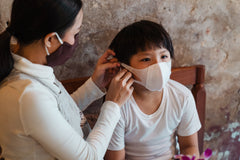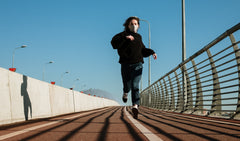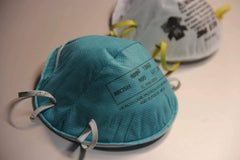FluShields Demonstrates Why Sneezing Is a Good Thing And Not Necessarily A Sign Of Corona

Photo by Andrea Piacquadio from Pexels
Sneezing is your body's way of removing irritants from your nose or throat. A sneeze is a powerful expulsion of air. Sneezing, another name for it is sternutation, often happens suddenly and without warning. Sneezes actually protect your body by clearing the nose of bacteria and viruses. When something enters your nose or you encounter a trigger that sets off your “sneezecenter” in your brain, signals are rapidly sent to tightly close your throat, eyes, and mouth.
When a foreign particle enters your nose, it may interact with the tiny hairs and delicate skin that line your nasal passage. These particles and contaminants range from smoke, pollution, and perfume to bacteria, viruses, mold, and dander.
When the lining of your nose experiences the first tinge of a foreign substance, it sends an electric signal to your brain. This signal tells your brain that the nose needs to clear itself. The brain signals your body that it’s time for a sneeze, and your body responds by preparing itself for the impending contraction. In most cases, the eyes are forced shut, the tongue moves to the roof of the mouth, and the muscles brace for the sneeze. All of this happens in just a few seconds. Sneezing forces water, mucus, and air from your nose with an incredible force. The sneeze can carry with it many microbes, which can spread diseases like the flu or the Coronavirus.
Sneezes also perform another vital role in the body. In 2012, researchers from the University of Pennsylvania discovered that sneezing is the nose’s natural way to “reset.” The study found that cilia, the cells that line the tissue inside the nose, are rebooted with a sneeze. In other words, a sneeze resets the entire nasal environment. What’s more, the researchers found that sneezing didn’t have the same “reset” effect on people who have chronic nasal issues like sinusitis. Figuring out how to reactive those cells may help treat these ongoing issues.
To be able to refrain from sneezing, wearing any protective mask can be a good way to distance yourself from surrounding particles and aerosols. Thus, of all symptoms of COVID-19 Disease, is this considered one of them?
Good news: You can protect yourself as much as possible by wearing an N95 respirator face mask: Get your N95 respirator masks for the whole family today.
1. fever
2. dry cough
3. tiredness
People who were infected by Corona concluded that sneezing has been part of their symptoms of having the disease. But of all symptoms, this is not considered as common and somewhat called a very mild one. When you’re sneezing but don't have any occurrences of common symptoms such as high fever, dry cough, and tiredness, your sneezing is likely not from coronavirus. People with mild symptoms who are otherwise healthy should manage their symptoms at home.
What are mild symptoms of Corona and when do you need to get worried?
Less common and mild symptoms are
1. aches and pains.
2. sore throat
3. diarrhea
4. conjunctivitis
5. headache
6. loss of taste or smell
7. a rash on the skin, or discoloration of fingers or toes
If your mild symptoms get worse, especially if you have difficulty breathing, seek medical help immediately. Serious symptoms are
1. difficulty breathing or shortness of breath
2. chest pain or pressure
3. loss of speech or movement
If you have serious symptoms, seek immediate medical attention. Always call before visiting your doctor or health facility. It takes 5–6 days from when someone is infected with the virus for symptoms to show, however it can take up to 14 days to recover.
To make it easy for you to understand what to do if you feel symptoms, here are some simple steps to take:
1. Stay at Home
Unless it is an emergency, to reduce your risk of catching or spreading illness, stay home if you feel sick, even if your symptoms are mild. Do not go to work, school, or public places, and avoid public transportation. Call your doctor or health care facility: If you have a medical emergency, call 911 and tell the dispatcher about your symptoms.
2. Prepare to answer questions to determine your risk
When you call your doctor or a health care facility, you will be asked about your risks for COVID-19. Risk factors include recent travel to certain countries or areas of the U.S., or exposure to an infected person.
For instance, people calling Johns Hopkins Health System hospitals or clinics are asked:
- Have you had close contact with someone diagnosed with COVID-19, the disease caused by the new coronavirus? (Close contact means having been within 6 feet of that person for an extended time, or being exposed to their cough or sneeze.)
- Do you have a cough, fever or chills, shortness of breath or difficulty breathing, muscle or body aches, sore throat, the new loss of taste or smell, diarrhea, headache, new fatigue, nausea or vomiting, or congestion or runny nose?
- Has a public health officer said you were potentially exposed to COVID-19.
3. Follow your doctors' instructions - always!
Based on your answers to the questions, the health care provider will provide instructions over the phone. You will be told if you need to be evaluated, and if so, what to do next. Based on your risk for COVID-19, your health care provider may recommend that you:
- Continue to monitor your health and call back if you develop a fever or respiratory symptoms.
- Stay home and await further instructions.
- Report to a designated medical care facility for evaluation and treatment. It’s best to go alone to your appointment. Do not bring children or other family members unless you need assistance. Wear an N95 or KN95 face mask when you step outside going into a public place
- Go to a clinic or emergency department if you have more severe symptoms, such as higher fever and severe shortness of breath. Wear your N95 or KN95 masks to avoid spreading the virus.
Sneezing is not particularly a “symptom” of a Corona infection. But it is considered as a possible way to attract others with the viruses you have. When you sneeze, the majority of it contains saliva that come from your mouth and nose passages. And as we all know by now, coronavirus could be manifested through salivas and other liquid substances that a person could have internally. When an infected person sneezes, droplets of his/her saliva might reach another person’s body leading them to also get infected by the virus. If you want to learn more about aerosols and what role they play in infecting others, please read our bog about recent studies on aerosols.
What can you do to protect yourself or protect others to get infected by the Coronavirus:
Cover yourself with an N95 or KN95 mask and, if possible, face shields to be able to refrain yourself from getting droplets from the infected person or spread the virus, if you are infected.
No matter what, social distancing is a must. A two-meter or 6 foot distance is a “must” thing to consider when going outside your home and interacting with several people in public or at work.
When you were to sneeze, cover your mouth to avoid spreading droplets around you with your arm or, if this cannot be avoided, by your hands. Make sure to wash your hands right after and sanitize with alcohol.
👇 FluShields donates 3% of every order you place. You can top, round up, or give as much as you fancy at checkout. Our team and our customers like you are proud to have...
Click the tiny info button for details 👆
Good news: You can actually protect yourself as much as possible by wearing an N95 respirator face mask: Get your N95 respirator masks for the whole family today.
Disclaimer: Please note that we can only pass on general information and cannot make any guarantees or be liable for any consequences of your decision making or behavior. Use good common sense and ask your healthcare provider or physician for advice.
Thanks for stopping by. Please leave your comments, ideas, or feedback below so we can continue to provide you with great content.




